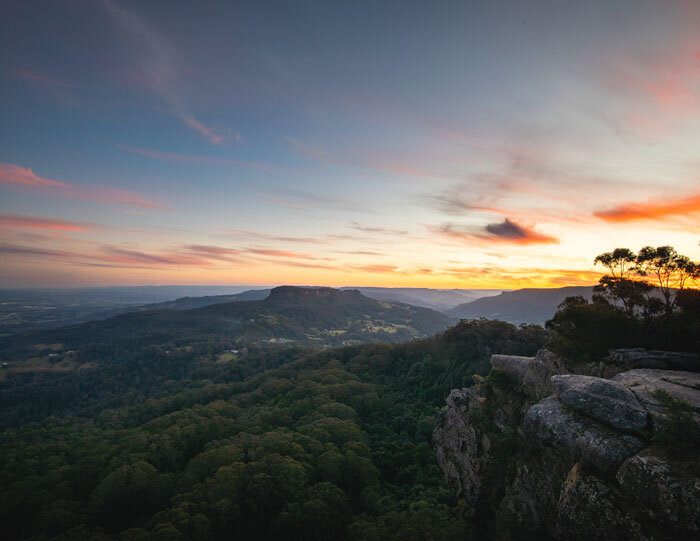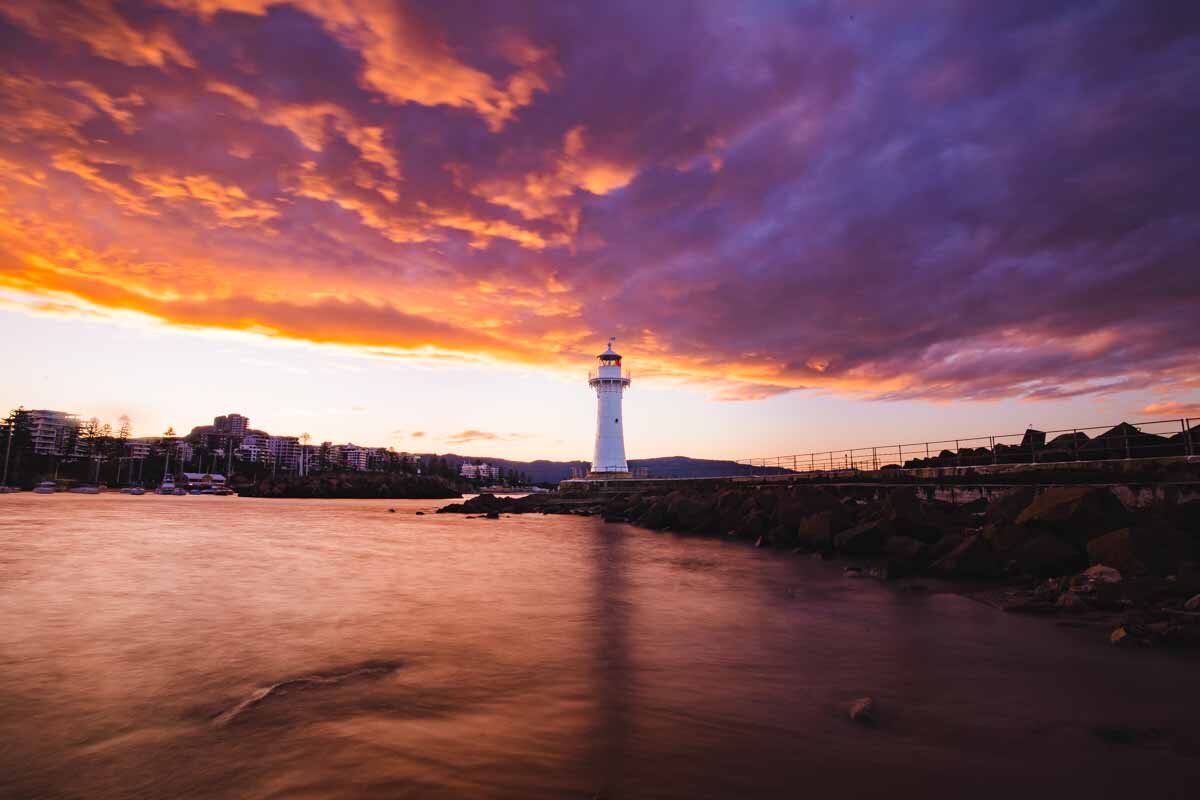The dramatic rock formations and sea stacks that make up Cathedral Rocks are no secret, but what’s less well known is that they are also home to some of the best rockpools in Kiama. With turquoise blue water and stunning backdrops, they make for an idyllic spot for a dip. There’s also a hidden beach and sea cave, all found on one short walk.
As long as you time your visit to coincide with low tide, this will likely be one of your favourite Kiama experiences.
Here’s what to expect from a visit to Cathedral Rocks.
Visiting Cathedral Rocks
Tides and safety
The best time to visit Cathedral Rocks if you want to take a dip in the rockpools is around 1.5 hours either side of low tide and with a slight swell. If you only want to visit the rocks, cave and beach you can extend this window by a couple of hours. The area around Cathedral Rocks may have large waves even during a slight swell, so you’ll also want to observe the water before heading into the pool.
Where to start the walk
Cathedral Rocks is located at the southern end of Jones Beach in Kiama. It can be accessed from the north or south, but the easiest access is to walk along Jones Beach. If you come from the south (heading north) you’ll have to do some scrambling, which can be tricky even during a low tide and swell. For this reason we recommend starting from Jones Beach which is a slightly longer route, but much easier.
The walk to Cathedral Rocks
The stats
Distance: 650m each way to the first rockpool, 150m each way to the second rockpool
Elevation gain: Flat
Difficulty: Easy
Trailhead: Jones Beach Car Park for the first rockpool, Cliff Drive for the second
The walk
From the car park at Jones Beach you need to head right, all the way to the far end of the beach where you can see the large headland. It’s approximately 450m of easy walking along the sand.
You’ll then head up onto the rock platform and from here you will be walking along the rock platform for just under 200m.
It’s easy and grippy when dry and as it’s long sloping rocks, not small ones or boulders, the footing is good. You’ll pass a tiny sliver of a rockpool almost immediately and then just under 100m in, you can cross over to the large rock platform on the left.
There is a small rockpool on the edge of the platform here, but you would need exceptional conditions to access it. Even 1.5 hours before low tide and during a slight swell, it was not safe to enter, maybe it never is, but it’s still a pretty spot to take a look at.
You’ll then cross back over to the other side of the rocks again and follow it for a minute or so until you reach the main view of Cathedral Rocks.
From here you can check out the small sea cave before continuing for around 50m to the tiny hidden beach and swimmable rockpool.
The Cathedral Rocks cave and beach
You’ll see the small cave set into the rocks on your right. At low tide there is no more than ankle deep water anywhere in the cave and even this can be avoided by rock hopping.
It’s a tiny cave and full of pebbles at the back, but what makes it special is the view from inside looking out to Cathedral Rocks. It’s dramatic and well worth a quick look before continuing to the beach.
From the cave you cross the rock platform and then you’ll see the beach to the right, nestled between the steep rock walls. It’s very small but absolutely gorgeous and the small channel of turquoise water leading up to it makes it even more picturesque.
To get to the beach you can walk across the uneven, but well tiered rocks and after just a few metres you will reach the sand.
You can’t swim straight from the beach as the channel is too narrow and has a large rock in the middle, but it’s pretty to look at.
Depending on the current you can swim in the next part of the channel, but this is much more exposed to the waves and potentially strong currents, so you need to be very mindful here and test the water around the shallow beach area first.
On our visit the current here was strong and it wouldn’t have been wise to swim, which wasn’t too disappointing as the rockpool is just a minute away!
The Cathedral Rocks Rockpool
From the small beach you need to climb along the rocks on the right wall and onto the next rock platform. This looks like it might be steeper and more exposed than it actually is. It’s actually very easy and nicely tiered, so there is no scrambling required.
You’ll then see the small rockpool directly in front of Cathedral Rocks.
There is one pool which is cut off from the ocean and one pool that is open to the ocean on one side. I picked the pool that was cut off - there was still a flow of water coming into the pool, but it’s enclosed and therefore at low tide and slight swell there is little worry of being swept out like there might be in the semi open pool.
Getting into the pool is easy as there are tiered rocks leading down into the water, which is very deep. The water is crystal clear and you could see right down to the pebbly bottom. The water was a brilliant shade of blue and the view is a hard one to beat! It’s not big enough to swim, but perfect for a lazy float.
As the rocks surrounding Cathedral Rocks are pounded with near constant waves it feels very dramatic. A little piece of calm amongst the storm!
Just remember to check conditions and watch the water for a while before getting in, you want to be sure that no large waves enter the pool (it’s always possible a rogue wave could come in, but it’s better to mitigate that risk as much as possible).
The second rockpool
If you want to try another spot, or if the conditions are not good enough for a dip at the main rockpool, you can continue to pool two. This can be done by scrambling along the rocks from pool one, or more easily by driving to this parking area on Cliff Drive and walking for a couple of minutes from there.
We opted for the latter. From the parking area linked above you’ll follow the worn grassy track gently downhill for 45m.
From here there’s a short 35m stretch of rock hopping, which is easy in shoes, but a little painful barefoot. Then you will see the rockpool on the small rocky outcrop to your right, it’s another 15m away.
Assuming it’s still low tide and swell and you can easily cross the rock platform. It’s also a very leisurely spot to get in to and out of the water, as you step straight into the sandy bottomed pool. The water is shallow, but there is enough to sit in, and the setting is, again, totally stunning.
The water is turquoise and you’re surrounded by rugged rock walls. You can hear the waves crashing beyond, but you’re perfectly cut off from it all, in your own little peaceful haven. If you’re after some relaxation, this is your spot!
You will find that people often come onto the nearby beach and rocks looking for views of Cathedral Rocks (as this is where the Cathedral Rocks road sign leads you to) but no one seems to venture to the pool. I couldn’t believe it given how lovely it is and how easy to reach!
Keep them wild
Please remember to take all rubbish with you and keep these places wild and pristine - as with anywhere in the outdoors. It’s important to leave them exactly as you found them so they will remain beautiful for generations to come.
Litter tends to breed litter, so if you do spot any and are able to pick it up and dispose of it outside the area, it will go a long way to keeping the area clean.
Getting to Cathedral Rocks
If you’re driving the best place to park is the car park by Jones Beach in Kiama, which you can see here on Google Maps. For the easiest access to rockpool two, park on Cliff Drive at -34.645881, 150.855538.
Cathedral Rocks is part of the Kiama Coastal Walk, which is how we visited it the first time, though make sure you line up your hike to arrive around low tide.
This post may contain affiliate links, meaning at no additional cost to you, that we will earn a small commission if you click through and decide to make a purchase. This helps towards the costs of running our website. Thanks for your support.



















































